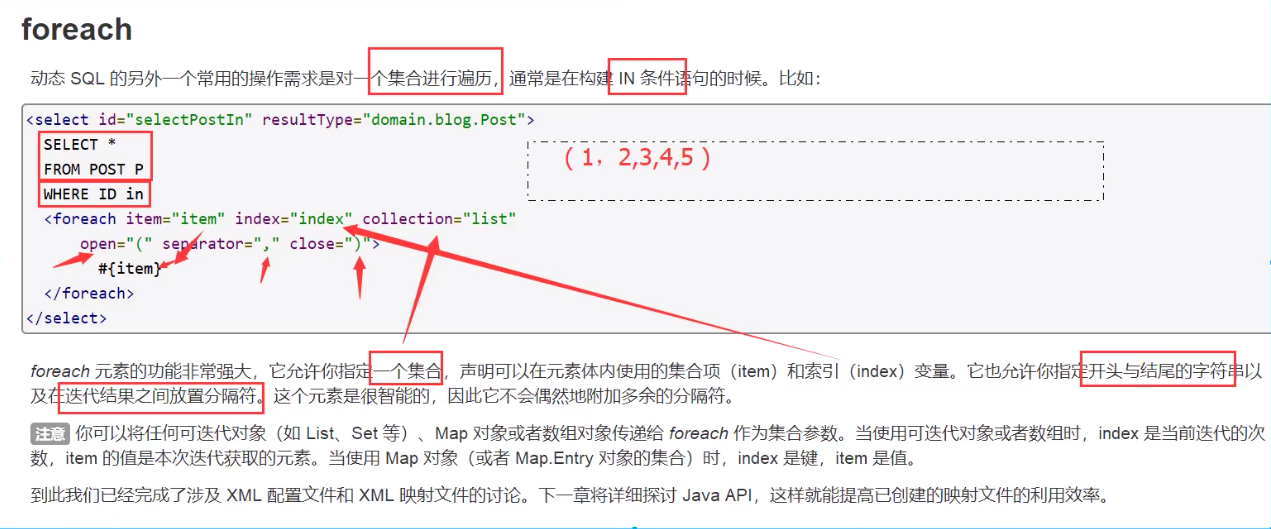12、动态SQL
什么事动态SQL:动态SQL就是指根据不同的条件生成不同的SQL语句
利用动态SQL这一特性可以彻底摆脱这种痛苦
动态 SQL 元素和 JSTL 或基于类似 XML 的文本处理器相似。在 MyBatis 之前的版本中,有很多元素需要花时间了解。MyBatis 3 大大精简了元素种类,现在只需学习原来一半的元素便可。MyBatis 采用功能强大的基于 OGNL 的表达式来淘汰其它大部分元素。
- if
- choose (when, otherwise)
- trim (where, set)
- foreach
搭建环境
CREATE TABLE `bolg`(
`id` VARCHAR(50) NOT NULL COMMENT '博客id',
`title` VARCHAR(100) not null comment '博客标题',
`author` VARCHAR(30) not null comment '博客作者',
`creat_time` datetime not null comment '创建时间',
`views` int(30) not null comment '浏览量'
)ENGINE=InnoDB DEFAULT CHARSET=utf8
创建一个基础工程
-
导包
-
编写配置文件
-
编写实体类
@Data public class Blog { private int id; private String title; private String author; private Date creatTime; private int views; } -
编写实体类对应的Mapper接口和Mapper.xml
IF
<select id="queryBlogIF" parameterType="map" resultType="com.rui.pojo.Blog">
select * from mybatis.bolg where 1=1
<if test="title != null">
and title = #{title}
</if>
<if test="author != null">
and author = #{author}
</if>
</select>
@Test
public void queryBlogIF(){
SqlSession sqlSession = MyBatisUtils.getSqlSession();
BlogMapper mapper = sqlSession.getMapper(BlogMapper.class);
HashMap map = new HashMap();
map.put("author","尹锐");
List<Blog> blogs = mapper.queryBlogIF(map);
for (Blog blog : blogs) {
System.out.println(blog);
}
sqlSession.close();
}
choose (when, otherwise)
<select id="queryBlogChoose" parameterType="map" resultType="com.rui.pojo.Blog">
select * from mybatis.bolg
<where>
<choose>
<when test="title != null">
title=#{title}
</when>
<when test="author!=null">
and author = #{author}
</when>
<otherwise>
and views = #{views}
</otherwise>
</choose>
</where>
</select>
trim, (where, set)
select * from mybatis.bolg
<where>
<if test="title != null">
title = #{title}
</if>
<if test="author != null">
and author = #{author}
</if>
</where>
<update id="updateBlog" parameterType="map">
update mybatis.bolg
<set>
<if test="title != null">
title = #{title},
</if>
<if test="author != null">
author = #{author},
</if>
</set>
where id = #{id}
</update>
所谓的动态SQL,本质还是SQL语句,只是我们可以在SQL层面,去执行一些逻辑代码
if
Where,set,choose,when
SQL片段
有的时候,我们可能会将一些公共的部分抽取出来,方便复用!
-
使用SQL标签抽取公共的部分
<sql id="if-title-author"> <if test="title != null"> title = #{title} </if> <if test="author != null"> and author = #{author} </if> </sql> -
在需要使用的地方使用Include标签引用即可
<select id="queryBlogIF" parameterType="map" resultType="com.rui.pojo.Blog"> select * from mybatis.bolg <where> <include refid="if-title-author"></include> </where> </select>注意事项:
- 最好基于单表来定义SQL片段!
- 不要存在where或者set标签,片段里尽量只有if就好了
Foreach
select * from user where 1=1 and <foreach item="id" index="index" collection="ids" open="(" separator="or" close=")"> #{id} </foreach> (id=1 or id=2 or id=3)

1.
<!--
select * from mybatis.bolg where 1=1 and (id=1 or id=2 or id=3)
我们现在传递一个万能的map,这个map中可以存在一个map
-->
<select id="queryBlogForeach" parameterType="map" resultType="com.rui.pojo.Blog">
select * from mybatis.bolg
<where>
<foreach collection="ids" item="id" open="(" close=")" separator="or">
id = #{id}
</foreach>
</where>
</select>
动态SQL就是在拼接SQL语句,我们只要保证SQL的正确性,按照SQL的格式,去排列组合就可以了
建议:
- 先在Mysql中写出完整的SQL,在对应的去修改称为我们的动态SQL